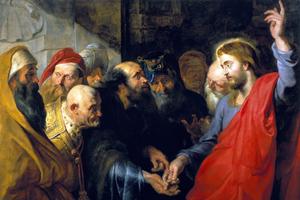20th Sunday in Ordinary Time: The Canaanite Woman
SCRIPTURES & ART: God’s salvific care is not confined to one people.

Today’s Gospel might seem harsh to some, challenging their preconceptions of Jesus as never saying not nice things or being confrontational. But it has important lessons to teach about faith and about Jesus’ outreach. Let’s listen to Jesus on his terms rather than ours.
Jesus “withdrew to the region of Tyre and Sidon.” Let’s back up in the Bible for a moment. Jesus had been in Galilee and multiplied loaves and fishes for the crowd. After the episode with Peter walking on water, he landed in Genneseret. He had also been accosted by the Pharisees who “came to Jesus from Jerusalem” (Matthew 15:1) to challenge his Jewish behavior by debating his seeming non-observance of ritual washings. Then he “withdrew to the region of Tyre and Sidon.”
Galilee is already on the periphery of Israel. Jesus’ activities primarily occur on the western shore of the Sea of Galilee. The eastern shore was the Decapolis, the “ten cities,” pagan territory. Even Tiberias, on the sea’s western shore, was deemed a pagan city in Jesus’ day, built by Herod Antipas to curry favor with the Roman Emperor Tiberius. By the time one reached Tyre and Sidon, then Phoenicia and now Lebanon, Jewish influence was minimal if existent.
That’s not to say the region didn’t play a role in sacred history. God sent the great prophet Elijah to Zarephath, a city between Sidon and Tyre, and put him in the care of a local widow (1 Kings 7:7-16), teaching him that God was God even of these pagans and they, too, had a role in his designs.
Jesus is “in the region of Tyre and Sidon.” As usual, his reputation precedes him and he is sought out by a “Canaanite” woman whose daughter is diabolically possessed. The mention of her ethnicity is intentional: she is no Jew. That does not change a mother’s concern for her child.
Jesus initially ignores her. The Apostles, those first-century gatekeepers still waiting for prime seats when the Kingdom is restored to Israel, want to get rid of her. Even Jesus challenges her: “I was sent only to the lost sheep of the house of Israel.” But she persists.
That’s when the animal analogies get sharp. Having said he was there for the “lost sheep of Israel,” Jesus now speaks of them as “children,” and “it is not right to take the food of children and throw it to the dogs.”
Is Jesus testing her for her faith against the cultural context of ancient Israel?
Both rabbinical Judaism and later Islam regarded dogs as impure. “Dogs” can be a pejorative term in the Middle East to refer to those outside one’s faith. So the world has in some sense not changed much in two millennia.
The Canaanite woman is desperate, desperate enough to take the remark and turn it around: “Even the dogs eat the scraps that fall from the table of their masters.”
We may think of “masters” in relation to a dog and his master, but there may be another level at operation in this text. Genesis 10 catalogs a variety of nations, including “Canaan” [as] the father of Sidon, his firstborn” (10:15). Canaan’s father, Ham, is cursed for having “looked upon” the nakedness of his father, Noah — that curse may have been taken by some Jews in Jesus’ time as justifying a subordinate relationship of the Canaanites.
In any event, Jesus frequently crosses Jewish boundaries to extend his saving grace beyond “the house of Israel,” and the same is true here. He praises her for her faith. Remember that, for a Jew, training in the faith was long and extensive, yet this pagan woman — a woman who lacked Israel’s revelation — penetrated more deeply to the essence of faith in Christ than, say, the Pharisaical representatives that had just been arguing with Jesus over ritual washings.
It is that faith, that openness to God’s work, that Jesus applauds and rewards. God “wills everyone to be saved and come to knowledge of the truth” (1 Timothy 2:4). Note what that passage says: God’s salvific will is universal. But God’s universally salvific will does not end at wanting “everyone to be saved.” God also wills they “come to knowledge of the truth.” St. Paul immediately follows up by affirming there is “one God” and “one mediator … Jesus Christ” (2:5). Let us not engage in the selective amputation of texts: God’s beneficent will is always also tied, in some way, to the Gospel that is Jesus Christ.
That is exactly what the Canaanite woman experienced.
It is an insight for which God had been preparing Israel through the generations. Among those in Matthew’s genealogy of Jesus (Matthew 1) are a Canaanite (Rahab) and a Moabite (Ruth, both v. 5) who played key roles in Israel’s history. The lesson of the Book of Jonah is that God’s care is not confined to one people.
Today’s Gospel is illustrated by the mid-18th century French artist, Jean François de Troy (1679-1752). Well positioned in French society, he had commissions to decorate the royal palaces in Versailles and Fontainebleau, and is largely known today for his depictions of and sales to the French society of his time. He was part of the rococo movement in art, a final variant of the Baroque, which spread not just to painting but to decorative arts. Rococo featured curves and graceful lines and pastel colors.
“Christ and the Canaanite Woman,” which comes from late in De Troy’s career (1743), shows far more Baroque than Rococo features. The sheer dimensions of the figures — especially the six major Apostles gathered around Jesus — are more Baroque. So are the contrasts of light and darkness, especially the background darkness against the relatively lighter figures of Jesus and the woman.
Against their generally dark and dusky colors, Jesus and the woman bring bright lighter, more dynamic colors — blue, reddish, even a touch of white (in her headdress and complexion) — into the picture. There is also some degree of circular curvature, especially from Jesus’ hand around the woman, whose foot is adjacent to Christ’s, and then up around through the curve of his cloak.
Note the three hand gestures. The Apostle on the far left (Peter?) is pointing her out: she’s not one of us, she’s a pagan, get rid of her. The woman, with eyes humbly cast down, points with both hands to the dog at her feet, clearly alluding to her reply to Jesus. And Jesus’ hand arrests Peter’s accusatory finger, pointing to the faith he has just witnessed in her.
The painting is on view at the Chrysler Museum in Norfolk, Virginia.
- Keywords:
- Scriptures & Art

















